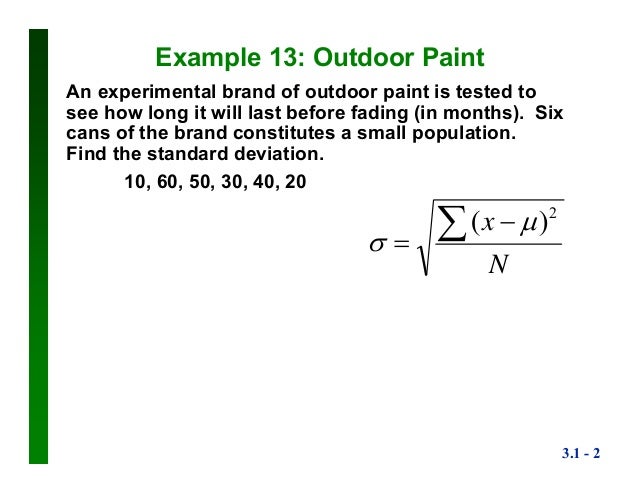How do you calculate standard deviation of a data set? What is the formula for finding standard deviation? What does standard deviation show us about our data?

Scientists and statisticians use the standard deviation to determine how closely sets of data are to the mean of all the sets. The standard deviation is the square root of the variance. Thus the way we calculate standard deviation is very similar to the way we calculate variance.
In fact, to calculate standard deviation , we first need to calculate the variance, and then take its square root. In statistics, the standard deviation (S also represented by the lower case Greek letter sigma σ for the population standard deviation or the Latin letter s for the sample standard deviation ) is a measure of the amount of variation or dispersion of a set of values. An example of this in industrial applications is quality control for some product. Place the cursor where you wish to have the standard deviation appear and click the mouse button. Select Insert Function (f x) from the FORMULAS tab.

A dialog box will appear. S (for a sample) from the the Statistical category. Note: If your data are from a population, click on STDEV.
If you round the standard deviation to one significant digit, that will tell you in which decimal place the uncertain digit of your final result lies. In probability and statistics, the standard deviation is a measure of the dispersion of a collection of values. It can apply to a probability distribution, a random variable, a population or a data set. For each value x, subtract the overall avg (x) from x, then multiply that result by itself.
Imagine that your lab group decided to carry out an experiment investigating the effect of Solvay. This can be useful, for instance, when comparing data gathered from a lab experiment to a known weight or density of a substance. Another useful statistic is the sample standard deviation, s, which is the square root of the sample variance, σ. The quantity n-is the number of degrees of freedom associated with the sample standard deviation. It is often the case that we are more interested in the estimate of the mean than in the individual observations. With discrete random variables, sometimes you’re given a probability distribution table instead of “p” and “n”.
Two standard deviations, or two sigmas, away from the mean (the red and green areas) account for roughly percent of the data points. Three (3) standard deviations (the re green and blue areas) account for about percent of the data points. In a meta-analysis, the researcher found that the mean for the experimental group in a study was and the mean for the control group was 10.

Standard Deviation of Discrete Random Variables. The pooled standard deviation was 5. A confidence interval is set to illustrate the population mean intuitively. There are three main sources of experimental uncertainties (experimental errors): 1. Limited accuracy of the measuring apparatus - e. Mcannot determine applied force with a better accuracy than ±0. Limitations and simplifications of the experimental procedure - e. If the sampling distribution is normally distribute the sample mean, the standard error , and the quantiles of the normal distribution can be used to calculate confidence intervals for the true population mean. Although the mean and median are out there in common sight in the everyday media, you rarely see them accompanied by any measure of how diverse that data set was, and so you are getting only part of the story.
Watch the video, or read on below: The relative standard deviation (RSD) is a special form of the standard deviation (std dev). However, the standard deviation is the most common way to characterize the spread of a data set. The treatment group had a mean of 23.
Presenting Descriptive Statistics in Graphs When you have a large number of to report, you can often do it more clearly and efficiently with a graph. So, for example, if the real value that is measured is half of the measurements are 1. The precision of a measurement is how close a number of measurements of the same quantity agree with each other.
Nincsenek megjegyzések:
Megjegyzés küldése
Megjegyzés: Megjegyzéseket csak a blog tagjai írhatnak a blogba.